Your cart is currently empty.
Choose Your Greeting Card Design:
You May Also Like These

Subtotal
$0.00
Shipping & Handling :
Calculated in Checkout
Total
$0.00
Your cart is currently empty.

Subtotal
$0.00
Shipping & Handling :
Calculated in Checkout
Total
$0.00
Your cart is currently empty.

Subtotal
$0.00
Shipping & Handling :
Calculated in Checkout
Total
$0.00
FREE SHIPPING ON ORDERS $65+

April 11, 2024

April 11, 2024
Welcome to our guide on the history of anime! Here you’ll find everything you need to know about the origins of this unique art form!

 >
>Welcome to our guide on the history of anime! Here you’ll find everything you need to know about the origins of this unique art form!
We're a small business in Wisconsin!




Step into the world of anime! This format of Japanese storytelling has a rich history dating back hundreds of years. Continue reading to learn about how this art form developed and how it’s taken over the world today in our all-in-one guide on the history of anime.
Anime has its origins in traditional Japanese art forms dating back to the 12th century. Buddhist monks created scrolls which would tell a story through sequences of illustrations.
The stories on the scrolls were often religious in nature, sometimes satirical, and could be very comedic—one such example shows men competing in a farting contest.
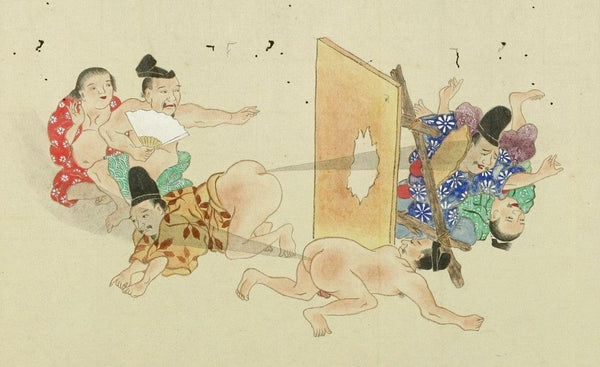
Scene of a He-gassen Scroll
These cartoons soon developed into an art form known as otsu-e, named after the city Otsu where they emerged in the 1600’s.
|
Art Movement |
Time Period |
Name Origins |
Description |
|
OTSU-E |
17th century |
Named after the city of Otsu where it emerged |
|
|
UKIYO-E |
17th – 19th centuries |
“Pictures of the floating world” |
|
|
MANGA |
19th century – present |
“Whimsical pictures” |
|
|
PONCHI |
19th century |
From the English word “punch,” as in the magazine The Japanese Punch |
|
Next came illustrations known as ukiyo-e, which translates to “pictures of the floating world.” Ukiyo-e were carved into wooden blocks and then printed onto paper. Scenes depicted the “floating world” of Yoshiwara, the upscale rich district within the capital city of Edo (now Tokyo). This art form’s display of the city’s nightlife as told in stylized illustrations would influence the art of manga centuries later.
Manga itself came about in the early 19th century. The term was coined by the famous artist Katsushika Hokusai, creator of the woodblock print The Great Wave off Kanagawa.
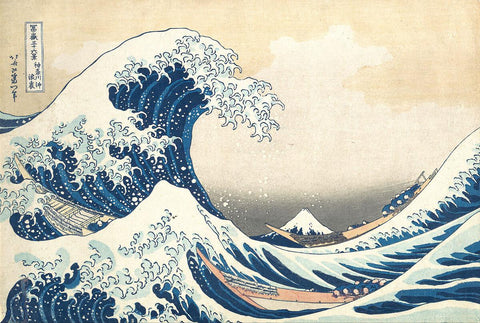
The Great Wave off Kanagawa
Hokusai’s style included simple but elegant lines which came together to tell powerful stories. He published his own volumes of Hokusai Manga, which included caricatures and political satire.

Images of the Hokusai Manga
Before long, books of storytelling through sequential illustrations became popular in Japan. These would be the precursors to modern-day manga—and, eventually, modern-day anime.
Manga is made up of two Japanese words: man, meaning “whimsical,” or “impromptu,” and ga, meaning “pictures.” It was coined by the famed artist Katsushika Hokusai.
The word began to be applied to story-telling picture books in the late 18th century.
Today, manga typically refers to Japanese comics, cartoons, or graphic novels. Anime refers specifically to Japanese animation, which is often adapted from manga.
In other words, manga are cartoon-style drawings on paper only, while all TV and movie adaptations are called anime.
The oldest known illustrated scroll dates back to the early 12th century. Known as "the Animal Scrolls” (Choju-giga) by Bishop Toba, these comic drawings depicted animals imitating humans, especially the wealthy and powerful, and were intended as satire.
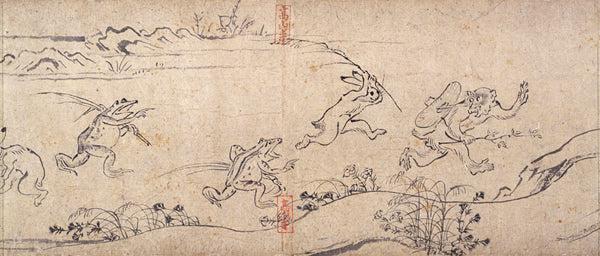
The Animal Scrolls
Another scroll credited as the first manga is the “Legend of Mount Shigi Emaki” (Shigisan Engi Emaki). Also from the 12th century, the images on this scroll displayed the many miracles of a monk named Myoren from Mount Shigi.

Legend of Mount Shigi Emaki
Modern-day manga as we know it would not develop until the early 20th century. Read on to learn more about how this art form developed and led to the first anime.
In the mid-1800’s, Western influence grew in Japan as powers like Britain and the US began sending ships into Japanese ports. One British news correspondent, Charles Wirgman, started a magazine called The Japan Punch which became very popular and ran for 25 years.

Images of The Japan Punch
Wirgman’s use of word balloons, which was commonly used in American cartoons at the time, would be adopted by Japanese illustrations. This became a new genre, called ponchi (from the word “Punch”) would describe what is now known as modern manga.
By the early 20th century, cartoons had become popular among Japanese audiences both in magazine and book form. This coincided with a rise in literacy rates among the Japanese, allowing for both images and words to be used in manga as was being done in Western comics.
Live entertainment like puppet shows, kabuki theater, and magic lantern shows—images shown in a sequence on a projector—had been enjoyed by the public for hundreds of years in Japan. The first cinemas opened in 1903, and the very fist animated films followed only a couple years later.
In 2005, an old Japanese cartoon reel was found which is now believed to be the first example of anime. Known as Katsudo Shashin (“Activity Photo” or “Motion Picture”), this 3-second animation depicts a little boy in a sailor outfit writing out the words “Katsudo Shashin.” Although it is impossible to know exactly how old this anime is, it is generally dated back to 1907.
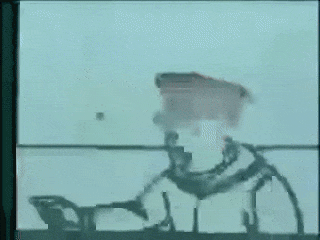
Katsudo Shashin (1907)
For the first 10 to 15 years of cinema in Japan, animated films featured publicly were mostly foreign creations. Finally, in 1917, Japan saw its earliest surviving animations hit the cinemas. One of the first known anime shorts was Nakamura Gatana (“The Dull Sword”), which lasted only a few minutes and told the humorous story of a foolish samurai buying a faulty sword with a dull edge.
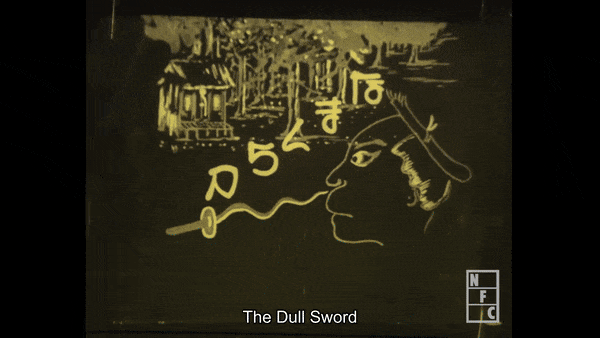
Beginning of The Dull Sword (1917)
While Katsudo Shashin (“Activity Photo” or “Motion Picture”) is possibly the oldest existing Japanese animation reel, it is not known whether this short was ever shown in cinemas.
Two existing films vie for the title of the world’s first known anime movie, both debuting in early 1917:
The Dull Sword (“Namakura Gatana”)
Mischievous New Picture Books (“Dekobo Shin Gacho”).
The first anime shorts were made using cutout animation, which involves using paper cutouts in the shapes of characters and props to tell a story through stop-motion. This was a more affordable style of animation popular among early independent filmmakers.
Studios with more funding used cel-animation, also known as classical or hand-drawn animation. This format makes use of celluloid sheets placed over painted backgrounds to portray the movement of hand-drawn characters.
In the 1920’s, the anime business was unexpectedly boosted by government funding. Film makers were hired to produce animated shorts on educational content and propaganda to be shown throughout Japan. Many influential creators of anime got their start in this way, such as Mitsuyo Seo and Kenzo Masaoka.
|
Title (English) |
Title (Japanese) |
Year |
Known For |
|
Activity Photo |
Katsudo Shashin |
~1907 |
Oldest known anime reel |
|
The Dull Sword |
Namakura Gatana |
1917 |
First known anime shown in cinemas (possibly) |
|
Mischevious New Picture Books |
Dekobo Shin Gacho |
1917 |
First known anime shown in cinemas (possibly) |
|
Kitayama Movie Factory |
Kitayama Eiga Seisakujo |
1921 |
First anime studio |
|
The World of Power and Women |
Chikara to Onna Yo no Naka |
1933 |
First anime film made entirely using cel animation |
|
The Dance of the Chagamas |
Chagama Ondo |
1934 |
First anime film made entirely using cel animation |
|
The White Snaked Enchantress |
Hakujaden |
1958 |
First color feature-length anime film |
|
Magic Boy |
Shōnen Sarutobi Sasuke |
1959 |
First feature-length anime film shown in the US (1961) |
The next decade in Japan saw a huge boom to the anime industry. The first anime studio was founded in 1921 by Kitayama Seitaro, known as the “Kitayama Movie Factory.”
The Great Kanto Earthquake of 1923, which destroyed many of Tokyo’s cinemas, actually served to further the anime industry by revolutionizing the anime style apart of the traditionalist culture within Tokyo. Only 3 years later, there were 178 active cinemas in the Tokyo area – 66 more than before the earthquake!
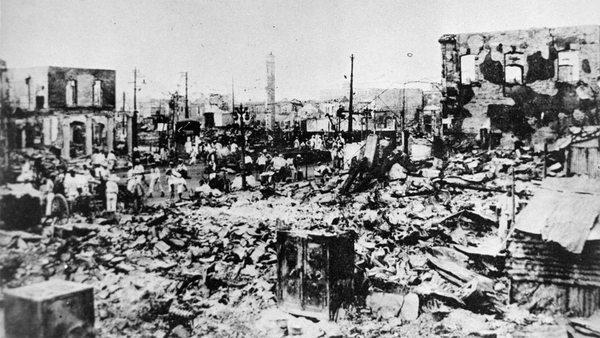
The Great Kanto Earthquake of 1923
By the early 1930’s, anime was a well-established and popular form of entertainment in Japan. The 1934 film Chagama Ondo (“The Dance of the Chagamas”) by Kenzo Masaoka was the first film to be made entirely using cel animation and received widespread praise. Masaoka’s 1933 film Chikara to Onna Yo no Naka (“The World of Power and Women”) was the first film to feature voice actors and even involved social commentary.
“Anime” is short for “animation,” and refers specifically to animated films or shorts. Outside of Japan, the word “anime” is used to refer specifically to Japanese animation.
The Japanese government funded anime-style short films to be created for educational and propaganda purposes.
This funding allowed many future anime filmmakers to gain experience and fame in the anime industry. Such big names include Mitsuyo Seo and Kenzo Masaoka.
The destruction of the Great Kanto Earthquake caused the anime industry to become more modernized. Anime artists detached from the traditional theater culture of Tokyo and experimented with new styles and themes.
During World War II, the rise of nationalism and propaganda heavily influenced the anime industry.
The Japanese government put pressure on anime artists to produce work that was nationalistic and patriotic. Censorship greatly increased, and filmmakers who refused to produce pro-government work were often pushed out of the industry or even arrested.
Government-sponsored films made during the war often showed skilled Japanese soldiers succeeding in battle against foreign enemies. Wartime propaganda efforts provided an additional boost to the industry, promoting anime feature films from big names like Kenzo Masaoka and Mitsuyo Seo.
One of the most notable examples of war-time anime propaganda is Mitsuyo Seo’s Momotaro no Umiwashi (“Momotaro’s Sea Eagles”). Made in 1943, this 37-minute anime portrays the Pearl Harbor attack through the lovable sailor Momotaro and his adorable soldier friends—who are mainly depicted as various types of animals. The animal sailors work together with Momotaro to defeat the evil forces of “Demon Island” (A.K.A., the American and British soldiers).
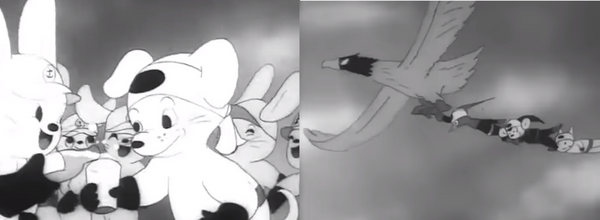
Scenes from Momotaro’s Sea Eagles (1943)
Targeted towards children, this anime was heavily influenced by Disney’s Fantasia (1940), as reflected in the art style. Its 1945 sequel Momotaro: Umi no Shinpei (“Momotaro: Sacred Sailors) was the first full-length anime feature film, also directed by Mitsuyo Seo.
Anime was also heavily impacted by the 1945 atomic bombings of Hiroshima and Nagasaki. This apocalyptic level of destruction would provide a theme explored in anime for decades, even up to the modern era of anime. Stories about war and its impact on innocent civilians would be portrayed in films like Grave of the Fireflies (1988) and Barefoot Gen (1983).
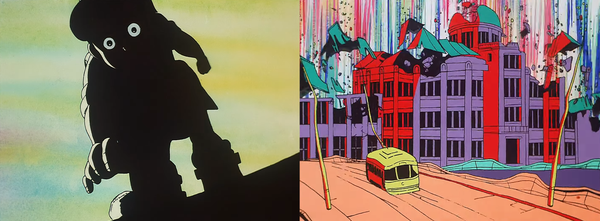
Scenes from Barefoot Gen (1983)
During World War II, the Japanese government promoted nationalism and patriotism through sponsored anime films. Censorship by the government prevented the satire and political criticism typical of pre-war anime.
Anime produced during the war mainly portrayed Japanese victory in battle. Despite all this, many quality films were produced during these years.
Themes of war would continue to be explored in anime for years to come.
The destruction caused by the 1945 bombings inspired apocalyptic themes in anime. Many creators focused on the consequences that war can have on innocent lives even decades later. Some examples of this include Grave of the Fireflies (1988) and Barefoot Gen (1983).
Many nationalistic anime portrayed Japanese (or generally Eastern) soldiers working together to overcome Western forces, which were portrayed negatively.
One of the most famous examples of propaganda anime is Mitsuyo Seo’s 1943 Momotaro no Umiwashi (“Momotaro’s Sea Eagles”), which told the story of Pearl Harbor from the perspective of the adorable hero, Momotaro.
The animal soldiers of this anime attack “Devil Island” to overcome the foreign forces. This anime was targeted towards children and used actual footage from Pearl Harbor.
After the Japanese loss in World War II, a Western occupation began which would last until 1952. Over 1 million American and British soldiers were present in post-war Japan, leading to heavy Western influence on—and control over—the anime industry.
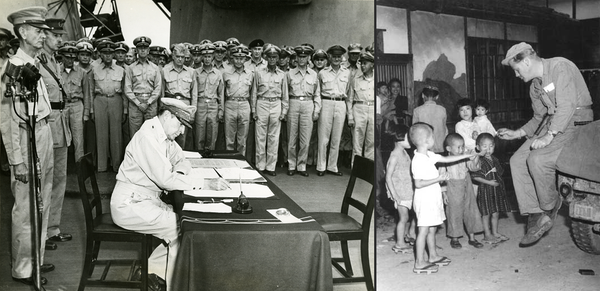
Douglas McArthur signing the Japanese surrender of WW2 (Left) & Japanese children seeing a Marine for the first time (Right)
During this time, producing anime discussing the war or portraying the Japanese forces in a positive light was discouraged by occupation forces. In contrast to wartime productions, post-war anime funded by the Occupation authority often involved pro-American and pro-democracy propaganda.
However, the Western influence in Japan also meant innovation and inspiration from foreign cartoon styles. This lead to an anime boom in the 1940’s and 50’s as creators explored new methods of storytelling and freed themselves of the nationalistic themes of wartime Japan.
Anime studios also began popping up during this time. Most notably, Toei Doga (now known as Toei Animation) was founded in 1956 when the Toei company bought out an animation company. The owner was inspired by Snow White and the Seven Dwarfs (1937) and set out to become the “Disney of the East.” This influential studio would later produce iconic anime such as Dragon Ball, Sailor Moon, Digimon, and One Piece.
In 1958, Toei Doga released the first feature-length anime film in color, The White Snake Enchantress (also known as Hakujaden, The Tale of the White Serpent, or Panda and the Magic Serpent). The movie was based on a well-known Chinese legend and represented a success for Toei. The studio would soon begin releasing new anime feature-films every year, hiring future anime legends like Takahata Isao and Hayao Miyazaki (who would later found Studio Ghibli).
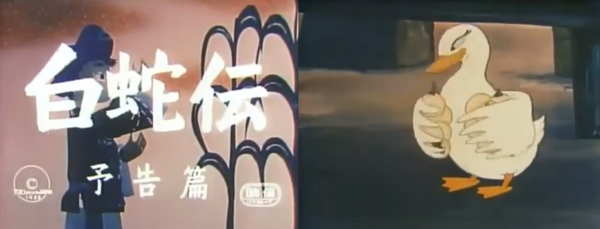
Scenes from Hakujaden (1958)
The Allied Occupation following World War II led to censorship of anime creators who wanted to produce pro-Japanese or anti-Western work. Instead, the Occupation authority funded anime featuring democracy in a positive light.
At the same time, the Western presence in Japan allowed for new styles of animation and experimentation inspired by Western cartoons. The anime industry boomed during these years, setting up for the success and popularity of the following decades.
The first feature-length anime film to be produced in color was Hakujaden, also known as The White Snake Enchantress or Panda and the Magic Serpent.
Released in 1958, this film was based on a popular Chinese legend and attempted to emulate the colorful animation seen in Snow White and the Seven Dwarves.
The 1960’s can be seen as the true birth of modern anime as we know it today. The familiar style of large-headed characters with exaggerated features began to appear in Japan’s first anime television series.
In 1961, anime finally made it to the United States. Toei Doga’s 1959 Shonen Sarutobi Sasuke was released by MGM studios as Magic Boy. Toei’s first hit film, Panda and the Magic Serpent (1958) became the second film shown in the US shortly after. These two hits would set the stage for America’s impending anime craze.
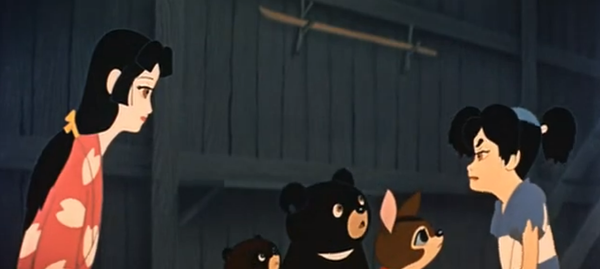
Scene from Magic Boy (1959)
Osama Tezuka—known as the “Father of Manga and Anime”—entered the scene in 1963 when he adapted his popular manga Astro Boy into the world’s first smash success anime television series.
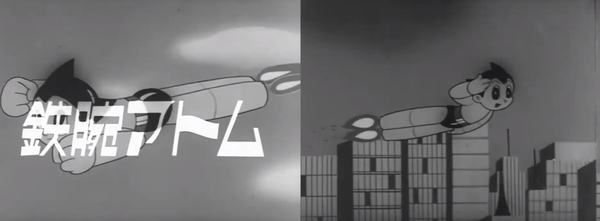
Scenes from Astro Boy (1963)
Tezuka’s style was revolutionary to both manga and anime in the following ways:
Complex and nuanced stories
Much longer than previous comics
Illustrations incorporated zooming and panning, as though from the viewpoint of a camera (inspired by American cartoons)
Highly cinematic
Characters drawn with large heads, eyes, and mouths (inspired by Disney)
Pushed towards realism with detailed sound effects
The storytelling elements first employed by Tezuka are now the standard among manga and anime. These include:
Long-term character arcs
Heroes that change and grow over time
Emphasis on the human experience
Emotional and captivating stories
Social commentary
Philosophical discussions and themes
Tezuka’s most famous work, Astro Boy, tells the story of a young android (robot) with human emotions living in a futuristic world where humans and robots co-exist. Tezuka’s iconic manga and anime explores questions of how technology might influence society and the potential tensions between robots and humans. This marked the invention of the “Mecha” genre of science fiction anime about robots.
Astro Boy launched the world into a full-blown anime frenzy. This came with a good amount of skepticism and even racism from foreign audiences, especially among parents worried about the foreign culture in which their children were immersed. However, the “Japanimation” obsession only increased among the younger generation.
By the 1970’s, anime had become intertwined with the TV industry. Budget concerns put constraints on the artistic abilities of creators, while merchandising and sponsorship by toy companies became an important aspect of anime production.
Landmark anime works of the 1970’s include:
Kyandi Kyandi (Candy Candy) (1976 – 1979)
Mobile Suit Gundam (1979 – 1980)
Lupin III (1971 – 1972)
Heidi, Girl of the Alps (1974) – created by future Studio Ghibli founders Hayao Miyazaki and Isao Takahata.
Osamu Tezuka is considered the “Father / Grandfather / Godfather of Manga and Anime.”

Images of Osamu Tezuka, The "Father of Manga"
His Disney-inspired art style featuring characters with big heads, eyes, and mouths would become the standard anime aesthetic.
Tezuka was the first to create cinematic anime that was complex, emotional, and nuanced in its storylines and character development. He set the standard for modern anime, and launched the world into an anime craze with his hit show Astro Boy in the 1960’s.
Osamu Tezuka’s most famous manga and anime is Astro Boy, a story about an android boy with human emotions. He invented the “mecha” genre with this influential anime.
Tezuka is also known for:
Princess Knight (1967)
Black Jack (1973)
Phoenix (1954)
Kimba the White Lion (or Jungle Emperor) (1950) – which many claim to have been an inspiration for Disney’s The Lion King.
The first feature-length anime film shown in the United States was Toei Doga’s Magic Boy in 1961. This was soon followed by the American release of Toei’s first color anime, Panda and the Magic Serpent.
The 1980’s ushered in what is commonly referred to as the “golden age” of anime. Shows within the genres of super-powered robots and space operas dominated this period—the latter of which was heavily influenced by the success of Star Wars in the US.
By this point, Japanese anime was the dominant force in the world of animation. Innovative anime like Akira (1988) began to target adults with mature themes and violence. Anime for adults grew in popularity with the invention of the video cassette recorder, allowing creators to offer straight-to-video content that would bypass television censorship.

Scenes from Akira (1988)
The generation of children that had fallen in love with Astro Boy in the 1960’s was now a full-grown audience of anime lovers. Fans came out by the thousands for feature-length anime films, injecting a much-needed economic boost into the industry.
By far the most influential anime studio of this so-called “golden age” was—and still is, many would argue—the iconic Studio Ghibli.
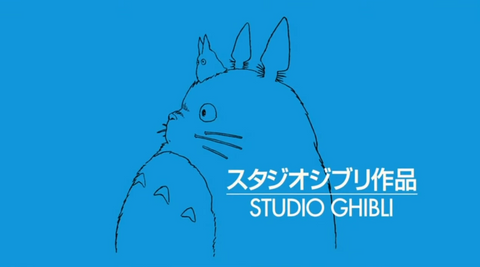
Studio Ghibli Logo
Studio Ghibli was founded in 1985 by experienced anime creators Hayao Miyazaki, Isao Takahata, and Toshio Suzuki. The word “Ghibli” comes originally from the Arabic word “Qibli,” which describes a hot desert wind, and was also the name of an Italian aircraft used in Libya during the ‘30s and ‘40s.
Miyazaki (who was a passionate flyer of aircrafts) chose this name to represent the “new wind” which he hoped to send through the anime industry.
Miyazaki and Takahata experienced success with their 1984 collaboration on Nausicaa of the Valley of the Wind, and decided to open a studio together to continue their work. The intention for Studio Ghibli was to create anime committed to quality and complexity. Their work was to be poetic and introspective in nature, inspiring audiences without the constraints of the commercial world which dominated television anime.
Studio Ghibli officially entered the scene with the 1986 film Castle in the Sky, which has since achieved a cult following among anime fans. Their first commercial success came in 1989 with Kiki’s Delivery Service, which grossed $40 million dollars at the box office as the top-earning film of the year.

Scenes from Castle In The Sky (1986)
Famous Studio Ghibli Films Include:
Castle in the Sky (1986)
Kiki’s Delivery Service (1989)
Princess Mononoke (1997)
Spirited Away (2001)
Howl’s Moving Castle (2004)
Ponyo (2008)
The Boy and the Heron (2023)
It was during the 1980’s that the otaku subculture first began to develop in Japan. The term "Otaku" describes the cultural niche of anime, manga, computer, and video game fandoms in Japan.
In 1986, the launch of Toei Animation’s Dragon Ball marked the beginning of the martial art genre that would dominate anime in the coming decades. Dragon Ball and its sequel series Dragon Ball Z together would grow into one of the most influential and beloved franchises in all of anime.
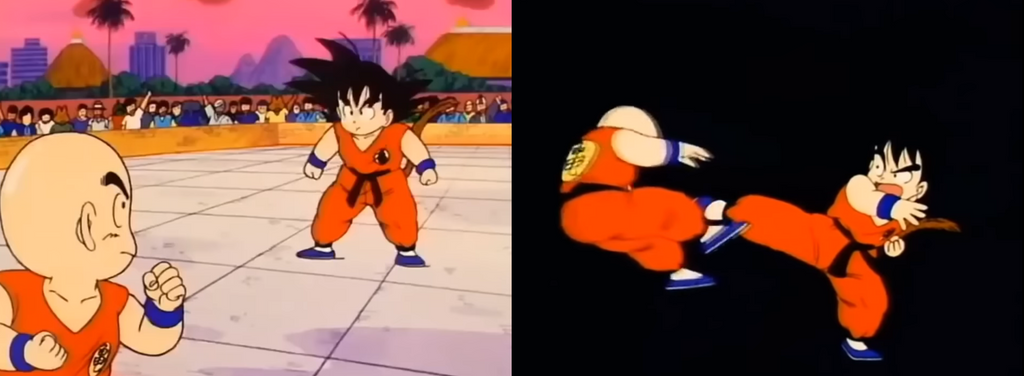
Scenes from Dragon Ball (1986)
The 1980’s was a period of trial-and-error innovation in Japanese anime. New genres were created, anime crossed into the world of video games, and ambitious experimental films were produced with many successes—and just as many failures.
The 1980’s are considered to have been the anime’s “golden age.” This flourishing was due largely to economic prosperity in Japan, allowing creators the budget to experiment with new styles of storytelling.
Furthermore, the audience grew more in the 1980’s than ever before—both within and outside of Japan—spurring a cultural revolution in the world of anime.
This “golden age” produced influential anime that would stand the test of time like Dragon Ball, Gundam, and the first Studio Ghibli productions.
The Star Wars craze in the United States influenced the futuristic themes of anime and the introduction of the Space Opera genre in the early 1980’s.
This impact can be seen in Science Fiction anime such as:
Star Blazers (1979)
The Macross Series (1982)
The Gundam Series (1979)
Legend of the Galactic Heroes (1988)
Neon Genesis Evangelion (1995)
Cowboy Bebop (2001)
Code Geass (2006)
Video cassette recorders allowed anime to be marketed directly to the consumer without having to be aired on television first. This meant that anime could target adults using mature themes that may not have been approved by television broadcasting companies.
Thus, the invention of the video cassette recorder encouraged the adult anime niche to grow in the 1980’s.
Studio Ghibli was founded in 1985 by anime creators Hayao Miyazaki and Isao Takahata, who had previously seen success with their 1984 collaboration Nausicaa of the Valley of the Wind.
The word “Ghibli” refers to an Italian aircraft from the World War II era. Miyazaki was passionate about aircraft and flying, and chose the name based on the plane.

Photos of The Caproni Ca.309 Ghibli Plane
“Ghibli” is derived from the Arabic word “Qibli,” referring to a desert wind. Miyazaki’s name choice reflected his desire to send a breath of fresh air or “new wind” into the anime industry.
Studio Ghibli’s first film was Castle in the Sky (1985), a fantasy story about two orphans being chased by pirates and government agents. They must escape to the legendary castle in the sky known as Laputa, which was taken from Jonathan Swift’s satirical story Gulliver’s Travels (1726).
Studio Ghibli’s first hit anime was, Kiki’s Delivery Service (1989). Also known as Witch’s Express Home Delivery, this fantasy movie centers around a young witch named Kiki and her talking cat Jiji. Together, they start a flying delivery service using her witch’s broom for transportation.
This film was the highest grossing movie of 1989, earning over $40 million at the box office and earning multiple awards.
Otaku refers to the members of the Japanese cultural movement dedicated to anime, manga, computers, or video games (but can include other hobbies, as well).
Otaku is a slang word which comes from a Japanese phrase meaning “Your House.”
There are several theories for why this word came to be associated with the otaku subculture. One possible reason is that people would use this phrase to ask if another person owned a specific book—in other words, asking if the book was at “your house.”
Some find the word to be offensive, since it is often associated with people whose fandom obsession implies a lack of social skills. However, in the West it is often used simply to refer to Japanese anime and manga fandom culture.
The 1990’s were a period of experimentation in anime that produced a generation of iconic children’s TV series beloved to this day, including Sailor Moon, Dragon Ball Z, Digimon, and Pokémon.
In terms of adult anime, the 1990’s saw the creation of the controversial Neon Genesis Evangelion (1995), which both catered to and criticized the otaku culture. Evangelion featured mature adult themes and heavy violence, causing an increase in television censorship which would affect other adult-themed shows like Cowboy Bebop in the late 90’s.
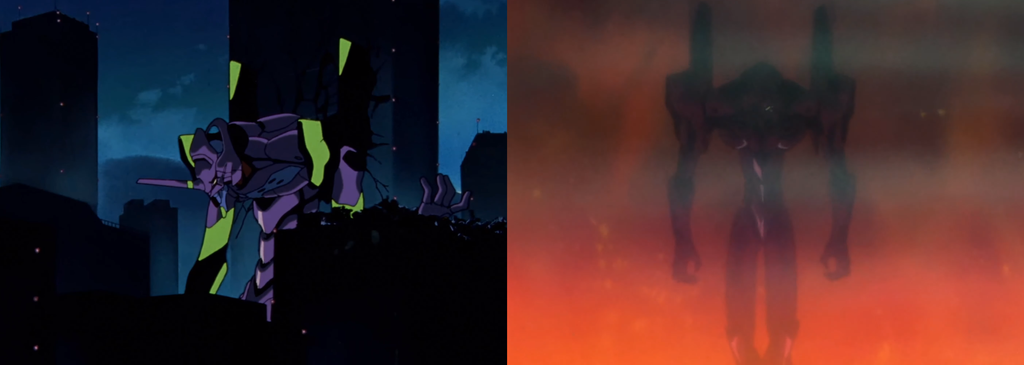
Scenes from Neon Genesis Evangelion (1995)
Evangelion was as influential as it was controversial, giving rise to a new genre of dark adult anime involving mecha themes. One popular example is Ghost in the Shell (1995), which would provide inspiration to the iconic American movie, The Matrix, produced only 4 years later.
Studio Ghibli’s success continued into the 90’s with Miyazaki’s Princess Mononoke (1997). This movie was the most expensive anime film to date, costing the studio over $20 million to produce and taking 144,000 cels to animate.
The cost was well worth it; the film was not only the highest grossing movie of 1997, but broke the Japanese box office record (a record which only be beat by Miyazaki himself in 2001). Princess Mononoke received endless praise both within Japan and abroad.
Perhaps the most iconic anime of this period was Pokémon. Derived from the title of “Pocket Monsters,” the Pokémon television series was adapted from the popular video games and aired for the first time in 1997. After over 800 episodes aired in Japan, Pokémon would become one of the longest-running anime and develop into one of the world’s best known anime franchises.
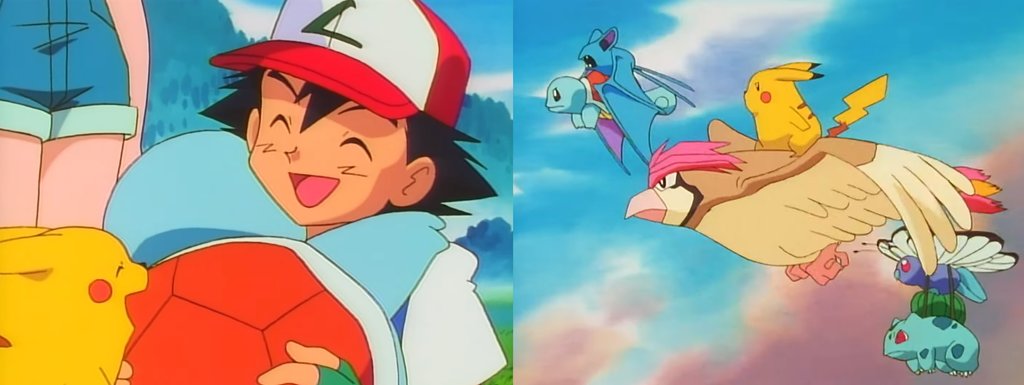
Scenes from the intro song of Pokémon (1997)
Sailor Moon debuted in 1996 as the first anime in the “magical girl” genre. Adapted by Toei animation from the popular manga series, the story follows a high school girl who transforms into a magical hero and leads her Sailor Soldiers through various fantastical adventures. To date, Sailor Moon still remains one of the best-selling manga series and is considered an iconic anime.
Evangelion contained adult themes involving violence and sexuality. It also criticized the very same otaku fans that made up its audience.
Despite being the most successful anime series of the 1990’s, TV Tokyo chose to increase censorship in response to the experimental series.
“Pokémon” is derived from the phrase “Pocket Monsters.”
Airing in 1997, the show revolves around creatures with magical powers known as “Pokémon” which humans catch in the wild and train to battle with other Pokémon. They capture these "monsters" in Poké Balls and carry them around in their "pockets," hence the name.
Created by Hayao Miyazaki, Studio Ghibli’s Princess Mononoke (1997) earned nearly $200 million at the box office, making it the highest grossing film of the year.
This blockbuster also broke the record for highest grossing Japanese film of all time, and would hold the title until 2001 (when it would be beat out by Miyazaki’s Spirited Away).
The early 2000’s in anime was characterized by a revival of older anime series and the blending of Japanese with American animation styles in the US.
The super robot genre of the 1960’s reemerged with shows like:
Mobile Suit Gundam Seed (2002 – 2003)
Mobile Suit Gundam 00 (2007 – 2009)
Guren Lagann (2007)
Macross Frontier (2008)
In October of 2002, the inaugural episode of Naruto aired, marking the beginning of a coming-of-age narrative centered around a young ninja striving to ascend to the leadership of his village (Hokage), all while contending with the presence of the Nine-Tailed Demon Fox sealed within him. Adapted from the successful 1999 manga series, Naruto swiftly rose to prominence, solidifying its status as one of the most beloved and widely recognized anime series in history.

Scenes from Naruto (2002)
During this period, Naruto gained widespread recognition as a key component of "The Big Three," a trio comprising the most prominent manga series concurrently serialized in the Weekly Shōnen Jump magazine. Alongside Naruto stood Bleach, which saw its manga debut in 2001 followed by its anime adaptation in 2004, and One Piece, whose manga first hit shelves in 1997, with its anime adaptation premiering in 1999. Remarkably, One Piece continues to air today, with an impressive episode count surpassing 1000, solidifying its status as the best-selling manga series of all time and one of the longest running anime series of all time.
Anime-inspired animation had been popping up in American cartoons since the 1990’s.
Many popular children’s shows had art styles clear influenced by Japanese anime, such as:
Dexter’s Laboratory (1995 – 2003)
Powerpuff Girls (1998 – 2005)
Samurai Jack (2001 – 2004)
Kim Possible (2002 – 2007)
My Life as a Teenage Robot (2003 – 2009)
The blending of American and Japanese art styles was embodied by the work of Glen Murakami in the early 2000’s. Working on shows like Batman: The Animated Series (1992) and related spin-offs, Murakami and American animator Bruce Timm were able to produce a new art style that incorporated elements of Japanese anime with genres like cyber punk and science fiction.
This new art style was dubbed “Murikanime.”
One of the most famous examples of an American cartoon series embodying the anime style is Nickelodeon’s Avatar: The Last Airbender (2005). The creators of the show credit Miyazaki with their artistic inspiration, and even incorporated elements of Eastern mysticism and martial arts into the show. Avatar: The Last Airbender blurred the lines so successfully that discussion began around whether a work must be Japanese to be considered anime.
A huge player in the American adoption of Japanese anime was Cartoon Network’s late-night programming block known as Adult Swim, and more specifically, Adult Swim's segment of "Toonami" (1997-2008).
Anime shows on Adult Swim (beginning in 2008) included:
Dragon Ball Z
Fullmetal Alchemist
Death Note
Inuyasha
Bleach
Cowboy Bebop
Durarara!!
Neon Genesis Evangelion
Lupin III
Many more
Other anime titles that dominated American airtime in the early 2000’s included:
One Piece (1999 – present)
Yu-Gi-Oh! Duel Monsters (2000 – 2004)
Fruits Basket (2001 – 2002)
Mew Mew Power (2002 – 2003)
Ouran High School Host Club (2002 – 2010)
Sonic X (2003 – 2005)
In 2001, Studio Ghibli outdid itself again with the release of Spirited Away.
Considered by most to be one of the greatest films of all time (not just within the category of anime), Spirited Away broke the previous Japanese box office record and was praised worldwide. At the 2002 Oscars, Spirited Away was nominated for the Best Animated Feature and won, making it the first anime film to earn an Academy Award.
Naruto is one of the most popular anime series of all time.
Based on the manga series of the same name, the original show followed the coming-of-age story of the young title character on his mission to become a Hokage (the leader of his village). However, the mischievous ninja must deal with the spirit of a Nine-Tailed Demon Fox which was sealed in his body when it attacked his village as a child.
Naruto has become one of the best-selling manga series to date. The original show aired from 2002-2007, and its successful sequel series Naruto: Shippuden ran from 2007-2017.
The story continues today in the manga and anime series Boruto: Naruto Next Generations, following the story of Naruto’s son, Boruto.
Shōnen anime, or "young boys' animation," constitutes a genre of Japanese manga and anime aimed at adolescent boys, focusing primarily on action, adventure, and battles against adversaries like monsters and evil forces. While its target demographic ranges from 9 to 18-year-old males, its appeal extends to audiences of all ages and genders. Shōnen anime is characterized by distinct visual styles, often featuring characters with spiky hair and exaggerated expressions. Published in dedicated manga magazines such as Weekly Shōnen Jump, shōnen manga maintains a significant presence in the Japanese manga market and enjoys widespread international popularity through series like Dragon Ball, Naruto, Bleach, and One Piece.
"The Big Three" anime refer to Naruto, Bleach, and One Piece, three immensely popular manga series serialized concurrently in the Weekly Shōnen Jump magazine during the 2000s. These series gained widespread recognition and popularity, becoming iconic staples of the shōnen genre and profoundly influencing the cultural landscape of manga and anime during that era. Although they were all adapted into anime, the term originated during their manga serialization.
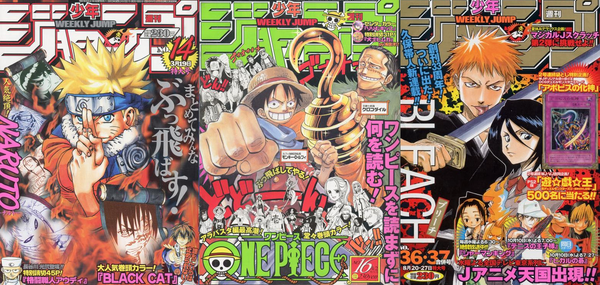
Weekly Shônen Jump magazine covers in 2001 featuring "The Big Three," Naruto, One Piece, and Bleach respectively.
“Murkianime” is a word referring to the art style of anime creator Glen Murakami.
Murakami was known for incorporating Japanese anime art styles into American animation in shows like:
Batman: The Animated Series (1992)
Batman Beyond (1999)
Superman: The Animated Series (1996)
Teen Titans (2003)
Teen Titans Go! (2013)
Ben 10: Alien Force (2008)
Ben 10: Ultimate Alien (2010)
Murakami’s style came to define American cartooning in the early 2000’s.
Created in 2005 by two Americans, Bryan Konietzko and Michael Dante DiMartin, Avatar: The Last Airbender incorporates elements of Japanese animation, Eastern philosophy, and martial arts.
Its unique “Americanime” style blurs the lines between Japanese and American animation, leading some to question whether the word “anime” should be reserved for Japanese creations.
In short, because it is a wholly American production with Japanese inspiration, it is generally not considered a true anime.
Studio Ghibli’s Spirited Away (2001) was the first anime film to earn an Academy Award. It was released by Disney for the American audience in 2002.
The film won the award for Best Animated Feature at the 2002 Oscars, beating out Ice Age, Lilo & Stitch, Spirit: Stallion of the Cimarron, and Treasure Planet. It was the first hand-drawn and the first non-American movie to win the award.
Miyazaki was nominated again in 2006 for Howl’s Moving Castle, but lost to Wallace & Gromit: The Curse of the Were-Rabbit.
In 2024, he won the category for a second time with The Boy and the Heron.
The past decade reflects the continued domination of anime in the mainstream media.
Attack on Titan (2013-2023) was heralded as the world’s “Most In-Demand TV series” in 2021. The show follows three friends living in a world in constant threat of giant Titans, and discusses questions of ethics and war.
Today, Attack on Titan is considered one of the greatest anime ever made. Its controversial themes have sparked debate about Japan’s Constitution (specifically Article 9), which outlaws war as a method of resolving international conflict.

Scenes from Attack on Titan (2013)
Despite briefly halting production in 2014, Studio Ghibli continues to make anime films today. Miyazaki’s 2023 The Boy and the Heron won the Academy Award for Best Animated Feature at the 2024 Oscars. Takahata sadly passed away in 2018 from lung cancer.
In 2020, history was made again when Demon Slayer: Kimetsu no Yaiba - The Movie: Mugen Train blew the box office away, despite being released during the COVID-19 pandemic.
Demon Slayer: Kimetsu no Yaiba - The Movie: Mugen Train records:
Highest-grossing Japanese film of all time (over ¥40 billion)
Fastest-grossing Japanese film of all time (¥10 billion in 10 days)
Highest-grossing film of 2020 worldwide ($507 million worldwide)
Highest opening weekend gross in Japanese history (¥4.6 billion)
Highest-grossing anime film of all time
First non-American (non-Hollywood) production to top the annual global box office
Highest-grossing R-rated animated film of all time
First film to top box office in Japan for 10 consecutive weekends
Attack on Titan is a popular anime series based on the best-selling manga of the same name. Set in a post-apocalyptic world, it depicts human civilization confined within massive walls to shield themselves from colossal humanoid Titans that decimated humanity.
Considered by many to be among the best anime in history, Attack on Titan became a worldwide sensation and was named 2021’s “Most In-Demand TV Series in the World.”
In the Constitution of Japan, Article 9 outlaws the use of war as a means of resolving disputes internationally.
Put in place in 1947 following World War II, Article 9 was a produce of the American Occupation authority in Japan at the time. It also forbids Japan from maintaining armed forces capable of offensive warfare.
Article 9 is highly controversial and has been addressed many times in Japanese anime. Online debate has been sparked in reaction to shows like Attack on Titan and Miyazaki’s 2013 film The Wind Rises, both of which discuss questions of pacifism and war.
Yes, Studio Ghibli still actively produces anime films. However, the company is under new leadership as Miyazaki has stepped down (but continues to work on films) and Takahata passed away in 2018.
In 2023, Miyazaki released The Boy and the Heron, which won the 2024 Academy Award for Best Animated Feature.
Demon Slayer: Kimetsu no Yaiba - The Movie: Mugen Train (2020) broke records as the highest-grossing anime film of all time, earning over ¥40 billion at the Japanese box office and $507 million worldwide.
It was also the first non-American film to top the annual box office worldwide, despite being released during the COVID-19 pandemic.
“A History of Manga in the Context of Japanese Culture and Society” by Kinko Ito (2005). Popular Culture Volume 38 (Issue 33), pages 456-475
Understanding Manga and Anime by Robin E. Brenner (2007).
Anime: A History by Jonathan Clements (2013).
“The History of Anime in Japan” by Serf Stanislaw (2023) – JapanJunky.
“The History of Anime” by Aileen Coutte (2013).
“A small glimpse into the history of Japanese anime” (2018) – Go! Go! Nihon.
“The Seeds of Anime: How Japanese Animation Arose” by Jonathan Clements (2020) – British Film Institute.
“The Evolution of the Japanese Anime Industry” by Yamaguchi Yasuo (2013) – Nippon.com
“How the ‘90s Anime Boom Changed Western Cartoons” by Timothy Donohoo (2019) – Comic Book Resources.
“How World War II Influenced Anime” by Joseph McLaughlin (2021) – Jotaku Network.
“Viewing the History of Japanese and U.S. Relations through Animation” by Abigail Wilkinson (2022) – The Nicholls Undergraduate Humanities Review.
“Manga: A Brief History in 12 Works” (2018) – The British Museum.
"Looking Back on the 1923 Great Kantō Earthquake" (2019) – Nippon.com
"SECURING THE SURRENDER: Marines in the Occupation of Japan" by Charles R. Smith (2018)
“The Origins of Toei Doga, Legendary Japanese Animation Studio” by Clemence Leleu (2021) – Pen Online.
“The History of Anime and Manga through WWII” by Brianna Barboza (2022) – GameRant.
“Studio Ghibli: Everything to know about the Japanese Animation Studio” by Claire Beghin (2020) – Vogue France.
Early Japanese animation, such as "Namakura Gatana" (1917), relied on hand-drawn techniques, featuring simplistic and often humorous themes. These pioneering works laid the foundation for the vibrant anime industry we see today.
World War II profoundly influenced Japanese animation. Amidst wartime censorship, anime served as a propaganda tool. Post-war, a scarcity of resources spurred innovative animation techniques, leading to the emergence of iconic post-war anime such as "Astro Boy."
Osamu Tezuka, often called the "God of Manga," revolutionized anime. His creations, like "Astro Boy," introduced complex storytelling and character development. Tezuka's influence shaped the modern anime industry, elevating it to a global phenomenon.
The popularity of manga provided a fertile ground for anime adaptation. Successful manga series often led to anime productions, leveraging existing fan bases and expanding the reach of both mediums. This synergy fueled the growth and diversification of anime content.
The term "otaku" emerged in the 1980s to describe avid fans of anime, manga, video games, and computers. This subculture flourished due to the increasing popularity of these media forms and the sense of community among enthusiasts.
Cartoon Network's Adult Swim, launched in 2001, introduced anime to US audiences by showcasing popular series like Dragon Ball Z and Cowboy Bebop. This helped mainstream anime, appealing to both casual viewers and dedicated fans.
Spirited Away, directed by Hayao Miyazaki in 2001, was both critically acclaimed and commercially successful, winning the Academy Award for Best Animated Feature. Its global recognition elevated anime as a respected art form beyond its niche audience, contributing to its mainstream acceptance worldwide.
Welcome to our video game comprehensive guide! Here, we’re covering the top-selling video games and genres of 2023, global revenue, player statistics,...
Tag: Data
What’s now one of the world’s most loved home consoles started out as a big company’s small hope to enter the world...
Tag: Data
If you’ve ever stopped to wonder about the origins of the company that created all your favorite childhood video games, you’ve come...
Tag: Data
Welcome, anime fans! Prepare to travel through the world of anime facts and statistics. From uncovering the rich history and origins of...
Tag: Data
A Comprehensive Guide to the Fascinating World of LEGO. Welcome, LEGO enthusiasts! Let’s dive deep into interesting LEGO statistics and facts. From...
Tag: Data
It’s no secret that board games can be a source of tension and frustration among families. We wanted to find out just...
Tag: Data
$65.00 away from free shipping!

Comments
Leave a comment